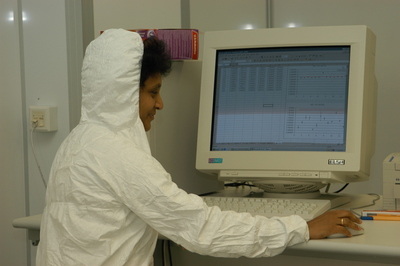
Samples taken in Iraq are screened using thermal ionization mass spectrometry for measuring very tiny amounts of uranium or plutonium.
(Source:
Dean Calma/IAEA)
A technique (also called surface ionization mass spectrometry)
whereby picogram to microgram quantities of a sample are deposited
on a metallic filament which is then heated to 1600-2000ºC in a
high vacuum; this results in ionization of the sample. The ion
beams from the different isotopes present in the sample are
separated in a mass spectrometer and collected either sequentially
in a single detector or simultaneously in a set of multiple
detectors to yield isotopic ratios. The technique is extensively
used at the Safeguards Analytical Laboratory. Highly accurate
results require that sample cross-contamination be minimized.